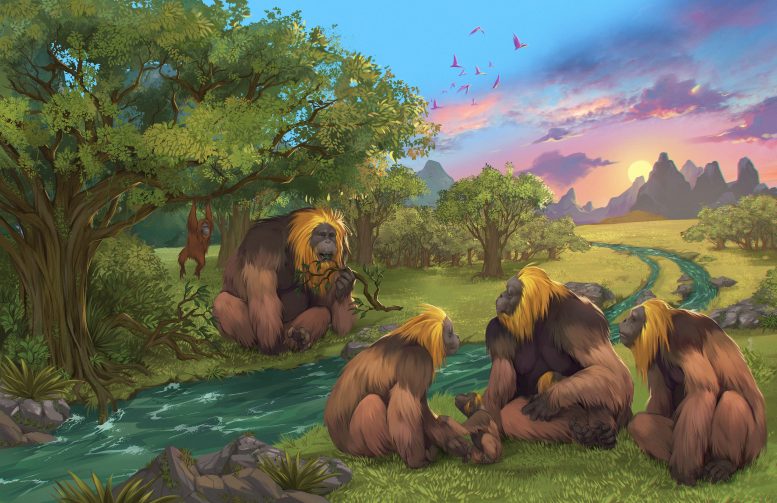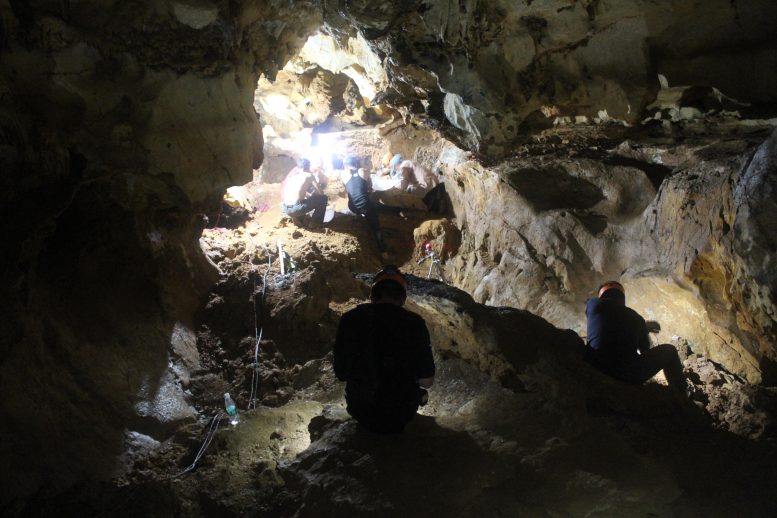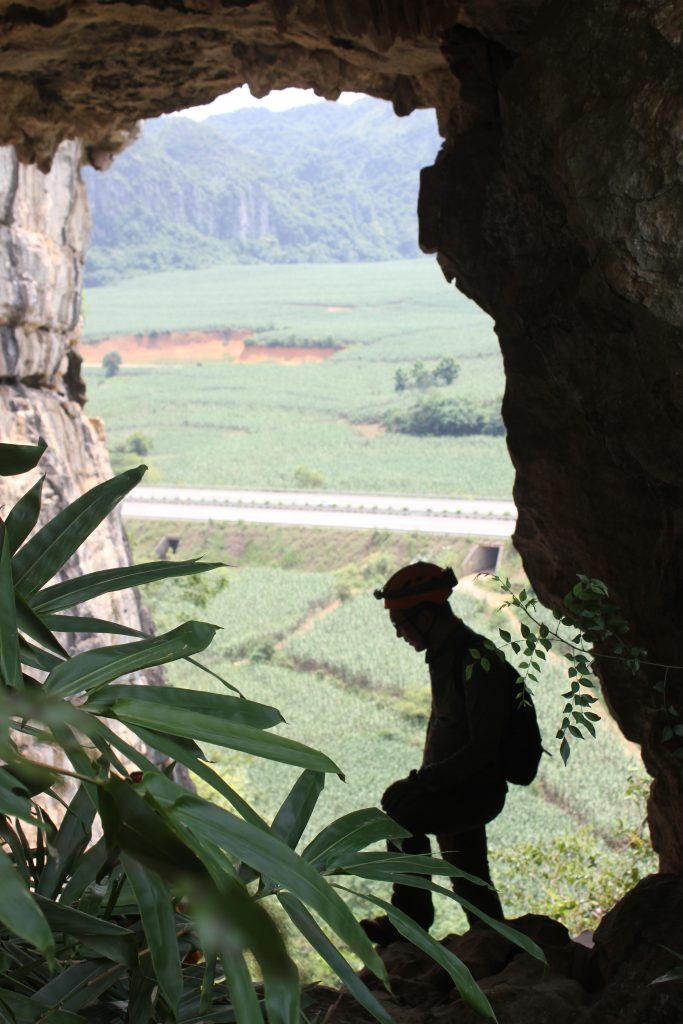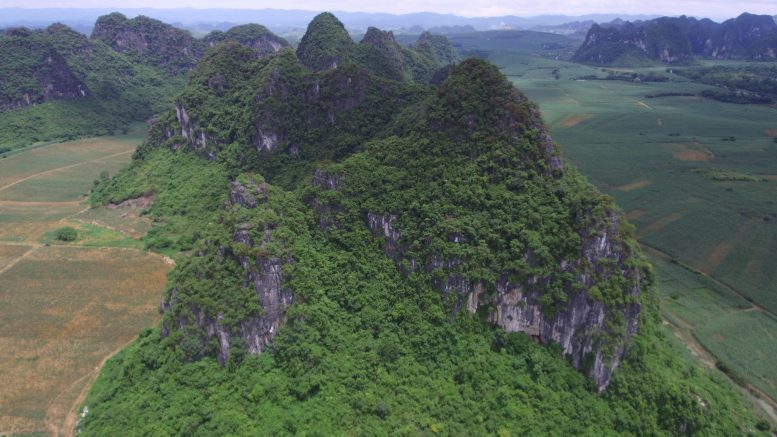
An artist’s impression of a group of G. blacki within a forest in southern China. Credit: Garcia/Joannes-Boyau (Southern Cross University)
In the karst landscapes of southern China, giant apes, known as Gigantopithecus blacki, once traversed the terrain. These massive creatures, standing three meters tall and weighing about 250 kilograms, are considered distant relatives of humans. Although they vanished before humans settled in the area, the reasons for their extinction remain largely a mystery. The only evidence of their former presence consists of approximately 2000 fossilized teeth and four jawbones.
New evidence from this region published in Nature, uncovered by a team of Chinese, Australian, and US researchers, demonstrates beyond doubt that the largest primate to walk the earth went extinct between 295,000 and 215,000 years ago, unable to adapt its food preferences and behaviors, and vulnerable to the changing climates which sealed its fate.
“The story of G. blacki is an enigma in paleontology – how could such a mighty creature go extinct at a time when other primates were adapting and surviving? The unresolved cause of its disappearance has become the Holy Grail in this discipline,” says paleontologist and co-lead author Professor Yingqi Zhang, from the Institute of Vertebrate Palaeontology and Palaeoanthropology at the Chinese Academy of Sciences (IVPP).
“The IVPP has been excavating for G. blacki evidence in this region for over 10 years but without solid dating and a consistent environmental analysis, the cause of its extinction had eluded us.”
Extensive Research Project
Definitive evidence revealing the story of the giant ape’s extinction has come from a large-scale project collecting evidence from 22 cave sites spread across a wide region of Guangxi Province in southern China. The foundation of this study was the dating.
“It’s a major feat to present a defined cause for the extinction of a species, but establishing the exact time when a species disappears from the fossil record gives us a target timeframe for an environmental reconstruction and behavior assessment,” says co-lead author, Macquarie University geochronologist Associate Professor Kira Westaway.

Digging into the hard cemented cave sediments containing a wealth of fossils and evidence of G. blacki. Credit: Kira Westaway (Macquarie University)
“Without robust dating, you are simply looking for clues in the wrong places.”
Six Australian universities contributed to the project. Macquarie University, Southern Cross University, Wollongong University and the University of Queensland used multiple techniques to date samples. Southern Cross also mapped G. blacki teeth to extract information on the apes’ behaviors. ANU and Flinders University studied the pollen and fossil-bearing sediments in the cave respectively, to reconstruct the environments in which G. blacki thrived and then disappeared.
Dating Techniques and Environmental Analysis
Six different dating techniques were applied to the cave sediments and fossils, producing 157 radiometric ages. These were combined with eight sources of environmental and behavioral evidence, and applied to 11 caves containing evidence of G blacki, and also to 11 caves of a similar age range where no G. blacki evidence was found.
Luminescence dating, which measures a light-sensitive signal found in the burial sediments that encased the G. blacki fossils, was the primary technique, supported by uranium-series (US) and electron-spin resonance (US-ESR) dating of the G. blacki teeth themselves.
“By direct-dating the fossil remains, we confirmed their age aligns with the luminescence sequence in the sediments where they were found, giving us a comprehensive and reliable chronology for the extinction of G. blacki,” says Southern Cross University geochronologist Associate Professor Renaud Joannes-Boyau.
Insights from Dental Analysis
Using detailed pollen analysis, fauna reconstructions, stable isotope analysis of the teeth, and a detailed analysis of the cave sediments at a micro level, the team established the environmental conditions leading up to when G blacki went extinct. Then, using trace element and dental microwear textural analysis (DMTA) of the apes’ teeth, the team modeled G. blacki’s behavior while it was flourishing, compared to during the species’ demise.

The G. blacki bearing cave of Zhang Wang lies 150 m above the valley floor making for a tough climb every day to conduct excavations. Credit: Kira Westaway (Macquarie University)
“Teeth provide a staggering insight into the behavior of the species indicating stress, diversity of food sources, and repeated behaviors,” says Associate Professor Joannes-Boyau
The findings show G.blacki went extinct between 295,000 and 215,000 years ago, much earlier than previously assumed. Before this time, G. blacki flourished in a rich and diverse forest.
Environmental Changes and Comparative Adaptation
By 700,000 to 600,000 years ago, the environment became more variable due to the increase in the strength of the seasons, causing a change in the structure of the forest communities.
Orangutans (genus Pongo) – a close relative of G. blacki – adapted their size, behavior, and habitat preferences as conditions changed. In comparison, G. blacki relied on a less nutritious backup food source when its preferences were unavailable, decreasing the diversity of its food. The ape became less mobile, had a reduced geographic range for foraging, and faced chronic stress and dwindling numbers.
“G. blacki was the ultimate specialist, compared to the more agile adapters like orangutans, and this ultimately led to its demise,” says Professor Zhang.
Associate Professor Westaway says: “With the threat of a sixth mass extinction event looming over us, there is an urgent need to understand why species go extinct.
“Exploring the reasons for past unresolved extinctions gives us a good starting point to understand primate resilience and the fate of other large animals, in the past and future.”
Reference: “The demise of the giant ape Gigantopithecus blacki” by Yingqi Zhang, Kira E. Westaway, Simon Haberle, Juliën K. Lubeek, Marian Bailey, Russell Ciochon, Mike W. Morley, Patrick Roberts, Jian-xin Zhao, Mathieu Duval, Anthony Dosseto, Yue Pan, Sue Rule, Wei Liao, Grant A. Gully, Mary Lucas, Jinyou Mo, Liyun Yang, Yanjun Cai, Wei Wang and Renaud Joannes-Boyau, 10 January 2024, Nature.
DOI: 10.1038/s41586-023-06900-0










Be the first to comment on "The Extinction of the Giant Ape: Scientists Solve Long-Standing Mystery"